RED BIRD PINK FLOWER: Jay Gao of Stony Brook captured this charming image of a male cardinal in his backyard on April 15 using a Nikon D5500 camera.
Send your Photo of the Week to [email protected].
RED BIRD PINK FLOWER: Jay Gao of Stony Brook captured this charming image of a male cardinal in his backyard on April 15 using a Nikon D5500 camera.
Send your Photo of the Week to [email protected].
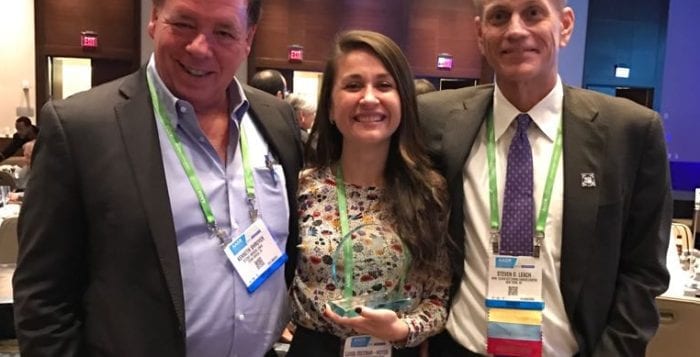
By Daniel Dunaief
While winter storm Niko in February closed schools and businesses and brought considerable precipitation to the region, it also coincided with great news for Luisa Escobar-Hoyos, who earned her doctorate from Stony Brook University.
Escobar-Hoyos, who is a part-time research assistant professor in the Department of Pathology at Stony Brook University and a postdoctoral fellow at Memorial Sloan Kettering Cancer Center, received word that she was the sole researcher selected in the country to receive the prestigious $600,000 Pancreatic Cancer Action Network–American Association for Cancer Research Pathway to Leadership Award.
When she heard the news, Escobar-Hoyos said she was “filled with excitement.” After she spoke with her husband Nicolas Hernandez and her current mentor at MSKCC, Steven Leach, the director of the David M. Rubenstein Center for Pancreatic Cancer Research, she called her parents in her native Colombia.
Her mother, Luz Hoyos, understood her excitement not only as a parent but as a cancer researcher herself. “My interest in cancer research started because of my mom,” Escobar-Hoyos said. Observing her example and “the excitement and the impact she has on her students and young scientists working with her, I could see myself” following in her footsteps.
The researcher said her joy at winning the award has blended with “a sense of responsibility” to the growing community of patients and their families who have developed a deadly disease that is projected to become the second leading cause of cancer-related death by 2020, according to the Pancreatic Cancer Action Network, moving past colorectal cancer.
The Pancreatic Cancer Action Network has awarded $35 million in funding to 142 scientists across the country from 2003 to 2016, many of whom have continued to improve an understanding of this insidious form of cancer.
David Tuveson, the current director of the Cancer Center at Cold Spring Harbor Laboratory, received funds from PanCan to develop the first genetically engineered mouse model that mimics human disease. Jiyoung Ahn, the associate director of the NYU Cancer Institute, used the funds to discover that two species of oral bacteria are associated with an over 50 percent increased risk of pancreatic cancer.
Over the first decade since PanCan started awarding these grants, the recipients have been able to convert each dollar granted into $8.28 in further pancreatic cancer research funding.
In her research, Escobar-Hoyos suggests that alternative splicing, or splitting up messenger RNA at different locations to create different versions of the same protein, plays an important part in the start and progress of pancreatic cancer. “Her preliminary data suggest that alternative splicing could be associated with poorer survival and resistance to treatment,” Lynn Matrisian, the chief science officer at PanCan, explained in an email. “The completion of her project will enhance our understanding of this molecular modification and how it impacts pancreatic cancer cell growth, survival and the progression to more advanced stages of this disease.”
Escobar-Hoyos explained that she will evaluate how mutations in transcriptional regulators and mRNA splicing factors influence gene expression and alternative splicing of mRNAs to promote the disease and aggression of the most common form of pancreatic cancer. Later, she will evaluate how splicing regulators and alternatively spliced genes enriched in pancreatic ductal adenocarcinoma contribute to tumor maintenance and resistance to therapy.
Escobar-Hoyos will receive $75,000 in each of the first two years of the award to pay for a salary or a technician, during a mentored phase of the award. After those two years, she will receive $150,000 for three years, when PanCan expects her to be in an independent research position.
Escobar-Hoyos said her graduate research at Stony Brook focused on ways to understand the biological differences between patients diagnosed with the same cancer type. She helped discover the way a keratin protein called K17 entered the nucleus and brought another protein into the cytoplasm, making one type of tumor more aggressive.
While Escobar-Hoyos works full time at Memorial Sloan Kettering, she continues to play an active role in Kenneth Shroyer’s lab, where she conducted experiments for her doctorate. She is the co-director of the Pathology Translational Research Laboratory, leading studies that are focused on pancreatic cancer biomarkers. The chair in the Department of Pathology, Shroyer extended an offer for her to continue to address the research questions her work addressed after she started her postdoctoral fellowship.
“When you do research projects and you develop them from the beginning, they are like babies and you really want to see how they evolve,” Escobar-Hoyos said. Numerous projects are devoted to different aspects of K17, she said.
Shroyer said Escobar-Hoyos had already been the first author on two landmark studies related to the discovery and validation of K17 even before her work with pancreatic cancer. “She has also conducted highly significant new research” that she is currently developing “that I believe will transform the field of pancreatic cancer research,” Shroyer wrote in an email.
Shroyer hopes to recruit Escobar-Hoyos to return to Stony Brook when she completes her fellowship to a full-time position as a tenure track assistant professor. “Based on her achievements in basic research and her passion to translate her findings to improve the care of patients with pancreatic cancer, I have no doubt she is one of the most promising young pancreatic cancer research scientists of her generation,” he continued.
Yusuf Hannun, the director of the Stony Brook Cancer Center, said Escobar-Hoyos’s work provided a new and important angle with considerable promise in understanding pancreatic cancer. “She is a tremendous example of success for junior investigators,” Hannun wrote in an email.
Escobar-Hoyos said she is hoping, a year or two from now, to transition to becoming an independent scientist and principal investigator, ideally at an academic institution. “Because of my strong ties with Stony Brook and all the effort the institution is investing in pancreatic research” SBU is currently her first choice.
Escobar-Hoyos is pleased that she was able to give back to the Pancreatic Cancer Action Network when she and a team of other friends and family helped raise about $4,000 as a part of a PurpleStride 5K walk in Prospect Park earlier this month.“I was paying forward what this foundation has done for me in my career,” she said.
Matrisian said dedicated scientists offer hope to patients and their families. “Researchers like Escobar-Hoyos spark scientific breakthroughs that may create treatments and ultimately, improve the lives of patients,” she suggested.
By Ed Blair

She was the quintessential “girl next door” — sweet, wholesome and unassuming. She was pretty and perky, had a dazzling smile and looked great in a cute summer dress. In short, she was the ideal, all-American girl every guy wanted to take home to meet his parents.
For many, Debbie Reynolds fit the classic romantic fantasy perfectly, whether she was dancing as an 18-year-old with Gene Kelly and Donald O’Connor in “Singin’ in the Rain” (1952), rollicking in “The Unsinkable Molly Brown” (1964), for which she received an Oscar nomination, or crooning her chart-topping 1957 hit “Tammy.”
Reynolds’ daughter, Carrie Fisher, earned her star as another type of princess in her iconic role in the “Star Wars” series. Their relationship, and their coinciding deaths, were headline material that generated wide media attention, and the sometimes contentious interactions between mother and daughter will be a featured in “The Debbie Reynolds Story,” a musical theater tribute being presented at The Ward Melville Heritage Organization’s Educational & Cultural Center from May 6 to June 15.

The center has hosted a number of shows orchestrated by St. George Productions, which has brought to life the biographies of stars such as Bob Hope, Patti Page, Mickey Rooney and, most recently, Mary Martin and Dinah Shore. As in the past, presentations will be followed by a luncheon catered by Fratelli’s Italian Eatery and includes tea and dessert.
In a format familiar to audiences who continue to enjoy his live musical theater tributes, director/writer/producer Sal St. George’s latest offering details the life of Debbie Reynolds and her on-again-off-again relationship with her daughter, Carrie Fisher.
Setting the show’s time line, St. George explained, “The year is 1977. Debbie has recently completed ‘Irene’ on Broadway, as well her one-woman show, and is touring with ‘Annie Get Your Gun.’” Reynolds had received a Tony nomination for Best Performance by a Leading Actress in a Musical for her role in “Irene,” and teenager Carrie Fisher had appeared on stage with her early during the musical’s run. “Carrie, now 20, is still in England promoting ‘Star Wars,’” St. George continued. “Although she is not [portrayed] in our show, Carrie’s relationship with her mother will be a major topic of discussion.”

Indeed, that relationship has been scrutinized and commented upon in the media since the deaths of the two stars became headline stories in December of 2016. Reynolds’ kaleidoscopic career and rags-to-riches road to stardom contrasted sharply with Fisher’s experiences.
Paris Pryor, the actress who portrays Reynolds in The WMHO production, paid tribute to the late star’s achievements, pointing out that, “Although her death is still fresh in our minds, I hope our presentation will be a positive reflection on her rich legacy.”
St. George noted that Lucille Ball, Jimmy Stewart and Rosemary Clooney lived in the same neighborhood as Reynolds, and his production features actress Jordyn Morgan, who portrays Clooney. “It is an honor,” said Morgan, “to be re-creating the life of such a remarkable musical artist. Our production is a salute to two of Hollywood’s greatest icons.”
The Ward Melville Heritage Organization’s Educational & Cultural Center, located at 97P Main St. in Stony Brook Village will present “The Debbie Reynolds Story” on May 6, 7, 10, 11, 13, 17, 18, 20, 21, 24 (sold out), 25 and 31; June 1, 3, 4, 7, 8, 10, 11, 14 and 15. Performances are at 11:30 a.m. (12:30 p.m. on Sundays). Admission is $48 adults; seniors (60 and over) and children under 15, $45; and groups of 20 or more $40. Advance reservations are required by calling 631-689-5888.
Created by Ward Melville in 1939 as The Ward Melville Community Fund, The WMHO is a not-for-profit organization founded to maintain and enhance historical and sensitive environmental properties and to develop and foster community enrichment through cultural and educational experiences. To learn more about The WMHO, call 631-751-2244 or visit the website at www.wmho.org.
By Kevin Redding
Strap in, old sport. The Long Island Museum in Stony Brook is bringing you back to the roaring twenties for a special fundraiser and examination of F. Scott Fitzgerald’s 1925 literary masterpiece. Chasing Gatsby: The Journey from Book to Film is a one-night event Saturday, May 6 from 5 to 7:30 p.m. that explores the enduring power of “The Great Gatsby,” Fitzgerald’s universally revered novel about excess and tragedy in the fictional town of West Egg on Long Island in the summer of 1922.
“To me, it doesn’t get any better than this for a program,” Neil Watson, the museum’s executive director, said. “We’re all really proud of what we’ve put together because it really pushes the limit for us of what’s possible in programming — it will bring theater, performance, the written word and Hollywood under one umbrella. There’s nobody else putting this kind of event together.”
Hors d’oeuvres and cocktails will be served to attendees as they follow the classic novel’s progression and interpretations throughout the years with the help of an impressive panel of guest speakers.
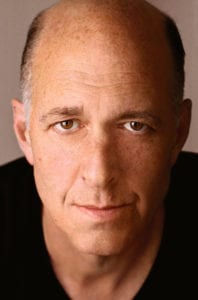
Actor John Bedford Lloyd, known for his film roles in “Crossing Delancey” and “The Abyss,” will join Tony Award-nominated actress Anne Twomey, best known for originating the stage role in “Nuts,” in reading selected excerpts from the book.
Christine Vachon, award-winning producer of the new Amazon series “Z: The Beginning of Everything,” based on the life of Fitzgerald’s infamous wife, Zelda, will discuss how three Hollywood film adaptations — the 1949 version starring Alan Ladd and Betty Field, the 1974 version starring Robert Redford and Mia Farrow and the 2013 version starring Leonardo DiCaprio and Carey Mulligan — approached the source material differently and show clips from each.
Maureen Corrigan, book critic for NPR’s “Fresh Air” will also be there to talk about her 2014 book, “So We Read On: How the Great Gatsby Came to Be and Why It Endures.”
Julie Diamond, director of communications, said the program has been in the works for about six months and will coincide with the museum’s Prohibition on Long Island exhibition May 5. “We try to organize public programs that correspond with our exhibitions, so Gatsby is complementary to that era of Prohibition in the 1920s and is highly regarded as one of the best examples of American literature,” she said.

Watson, who referred to “The Great Gatsby” as one of his favorite books of all time, said it didn’t take long for the program to take shape. “It started with the idea of just doing readings [from it] and really evolved quickly from that into a much more interactive experience,” he said. “To have this right in our backyard on Long Island, where the novel takes place, is wonderful.”
“We want the public to look at our museum and see this museum is about exhibitions we do, the carriage collection, the education programs we do, but also about this kind of program,” said Watson. “It’s really looking at the museum as a cultural hub for the area, and we want everybody to really take advantage of it because there’s so much here and the more we can do and the more we get the community responding we can up our game too.”
Watson called on his wife, Judy Blundell, a National Book Award recipient and successful author of books for young adult and adult readers, to moderate the event. “I’m so thrilled,” Blundell said in an email. “I can’t imagine a better group to discuss how and why this gorgeous novel manages to capture the imagination of generation after generation. In only nine chapters and 50,000 words, Fitzgerald delivers an iconic American story told in language and images consistently fresh every reading.”
“I think it’s a smart program and it has everything — it’s entertaining, it’s dramatic and it’s fun and you learn something too, which is great,” said Watson. “I think it’s going be a wonderful evening.”
Tickets for the event are $35 per person or $75 for premium seating and may be purchased online at www.longislandmuseum.org/events. The museum staff expects the limited-seating program to sell out, so act quickly, old sport.
The Long Island Museum, a Smithsonian affiliate, is located at 1200 Route 25A in Stony Brook. For more information, please call 631-751-0066.
By David Dunaief, M.D.

It is very interesting that the amount of coverage by the lay press concerning thyroid nodules does not reflect the number of people who actually have them. More than 50 percent of people have thyroid nodules detectable by high-resolution ultrasound (1); however, news coverage for general, nonphysician audiences is infrequent.
You can understand how coverage should be more in the forefront. Fortunately, most nodules are benign. A small percent, 4 to 6.5 percent, are malignant, and the number varies depending on the study (2). Thyroid nodules are being diagnosed more often incidentally on radiologic exams, such as CT scans of the chest, MRI scans, PET scans and ultrasounds of the carotid arteries in the neck (3).
There is a conundrum of what to do with a thyroid nodule, especially when it is found incidentally. It depends on the size. If it is over 1 centimeter, usually it is biopsied by fine needle aspiration (FNA) (4). This is the cutoff point for thyroid nodules found with a radiologic exam. Most are asymptomatic. However, if there are symptoms, these might include difficulty swallowing, difficulty breathing, hoarseness, pain in the lower portion of the neck and a goiter (5).
FNA biopsy is becoming more common. In a study evaluating several databases, there was a greater than 100 percent increase in thyroid FNAs performed over a five-year period from 2006 to 2011 (6). This resulted in a 31 percent increase in thyroidectomies, surgeries to remove the thyroid partially or completely.
However, the number of thyroid cancers diagnosed with the surgery did not rise in this same period. To make matters even more confusing, from 2001 to 2013, the number of thyroid cancers increased by 200 percent. In the study authors call for more detailed guidelines, which are lacking for thyroid nodules. Though the number of cancers diagnosed has increased, the mortality rate has remained relatively stable over several decades at about 1,500 patients per year (7). Thyroid nodules in this study were least likely to be cancerous when the initial diagnosis was by incidental radiologic exam.
Treating borderline results
As much as 25 percent of FNA biopsies are indeterminate. We are going to look at two modalities to differentiate between benign and malignant thyroid nodules when FNA results are equivocal: a PET scan and a molecular genetics test. A meta-analysis (a group of six studies) of PET scan results showed that it was least effective in resolving an unclear FNA biopsy. The PET scan was able to rule out patients who did not have malignancies significantly but did not do a good job of identifying those who did have cancer (8).
On the other hand, a molecular-based test was able to potentially determine whether an indeterminate thyroid nodule by FNA was malignant or benign (9). This test was a combination of microRNA gene expression classifier with the genetic mutation panel. I know the test combination sounds confusing, but the important takeaway is that it was more effective than previous molecular tests in clarifying whether a patient had a benign or cancerous nodule.
Unlike in the PET scan study above, the researchers were able to not only rule out the majority of malignancies but also to rule them in. It was not perfect, but the percent of negative predictive value (ruled out) was 94 percent, and the positive predictive value (ruled in) was 74 percent. The combination test improved the predictive results of previous molecular tests by 65 to 69 percent. This is important to help decide whether or not the patient needs surgery to remove at least part of the thyroid. The trial used hospital-based patients, but follow-up studies need to include community-based practices.
Is a negative FNA definitive?
We know that FNA is the gold standard for determining whether patients have malignant or benign thyroid nodules. However, a negative result on FNA is not always definitive for a benign thyroid nodule. When this occurs, it is referred to as a false negative result. In a retrospective (looking back at events) study, from the Longitudinal Health Insurance Database in Taiwan, 62 percent of thyroid nodules that were cancerous were diagnosed with one biopsy, and 82 percent were found within the year after that biopsy (10). However, about 17 percent of patients needed more than two FNA biopsies, and 19 percent were diagnosed after one year with cancerous thyroid nodules.
Significance of calcification on ultrasound
Microcalcifications in the nodule can be detected on ultrasound. The significance of this may be that patients with microcalcifications are more likely to have malignant thyroid nodules than those without them, according to a small prospective study involving 170 patients (11). This does not mean necessarily that a patient has malignancy with calcifications, but there is a higher risk. The results demonstrated that more than half of the malignant thyroid nodules, 61 percent, had microcalcifications.
Good news
As I mentioned above, most thyroid nodules are benign. The results of one study go even further, showing that most asymptomatic benign nodules do not progress in size significantly after five years (12). This was a prospective (forward-looking) study involving 992 patients with between one and four benign thyroid nodules diagnosed cytologically (by looking at the cells) or by ultrasound. The factors that did contribute to growth of about 11 percent of the nodules were age (<45 years old had more growth than >60 years old), multiple nodules, greater nodule volume at baseline and being male.
The authors’ suggestion is that the current paradigm might be altered and that after the follow-up scan, the next ultrasound scan might be five years later instead of three years. However, they did discover thyroid cancer in 0.3 percent after five years.
Thyroid function may contribute to risk
In considering risk factors, it’s important to note that those who had a normal thyroid stimulating hormone (TSH) were less likely to have a malignant thyroid nodule than those who had a high TSH, implying hypothyroidism. There was an almost 30 percent prevalence of cancer in the nodule if the TSH was greater than >5.5 mU/L (13).
The bottom line is that there is an urgent need for new guidelines regarding thyroid nodules. Fortunately, most nodules are benign and asymptomatic, but the number of cancerous nodules found is growing. We are getting better at diagnosing nodules. Why the death rate remains the same year over year for decades may have to do with the slow rate at which most thyroid cancers progress, especially two of the most common forms, follicular and papillary.
References: (1) AACE 2013 Abstract 1048. (2) Thyroid. 2005;15(7):708. (3) uptodate.com. (4) AACE 2013 Abstract 1048. (5) thyroid.org. (6) AAES 2013 Annual Meeting. Abstract 36. (7) AACE 2013 Abstract 1048. (8) Cancer. 2011;117(20):4582-4594. (9) J Clin Endocrinol Metab. Online May 12, 2015. (10) PLoS One. 2015;10(5):e0127354. (11) Head Neck. 2008 Sep;30(9):1206-1210. (12) JAMA. 2015;313(9):926-935. (13) J Clin Endocrinol Metab. 2006;91(11):4295.
Dr. Dunaief is a speaker, author and local lifestyle medicine physician focusing on the integration of medicine, nutrition, fitness and stress management. For further information, visit www.medicalcompassmd.com or consult your personal physician.
By Linda Toga, Esq.
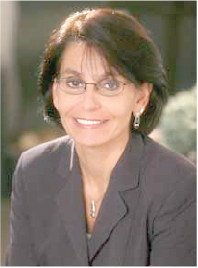
THE FACTS: Since my grandchildren, twin boys, were born seven years ago, I have cared for them five days a week while my daughter and son-in-law worked. My daughter is in the process of a divorce and my son-in-law will likely have shared custody. He is threatening to prohibit me from seeing the boys.
THE QUESTION: What rights do I have as a grandparent to see my grandchildren?
THE ANSWER: Since you have clearly been a big part of your grandchildren’s lives up to this point and have developed a meaningful relationship with the boys as a result of the extensive time you’ve spent caring for them, your interest in having a continued relationship with your grandchildren is protected by the New York Grandparent Visitation Statute (Domestic Relations Law §72).
The statute is designed to protect the interests of grandparents who have fostered a deep and significant relationship with their grandchildren. Unlike some similar statutes in other states, the New York statute does not require the grandparent to prove the existence of special factors in order to maintain visitation rights. In fact, some argue that the statute is too “grandparent friendly” and that it unfairly infringes upon the rights of fit and loving parents to make important child-rearing decisions.
HOW IT WORKS: When fairness dictates continued access by a grandparent to a grandchild, a grandparent who is denied access to that grandchild may petition the court for visitation rights. Notice of the petition must be given to the parent(s) or guardian(s) of the minor child who is advised of the date on which the court will conduct a hearing to determine if the grandparent’s request will be granted.
The court engages a two-prong test when deciding a grandparent visitation case. The first question the court must answer is whether the grandparent has “standing” to seek visitation. In other words, the court must determine if the grandparent has developed a relationship with the grandchild that deserves protection.
There are many factors considered by the court including the quantity and quality of time the grandparent has spent with the grandchild. A grandparent who has not played a significant role in the life of her grandchild and who has had very little contact with her grandchild will likely be found to not have standing. If that case, the petition will be dismissed.
Based upon the facts you’ve provided, it is likely that the court would find that you have standing. Once standing is found, the court will conduct a hearing to determine if grandparent visitation is in the best interest of the grandchild.
Based on testimony from the grandparent, the parent and either the grandchild or an attorney appointed by the court to represent the grandchild’s interests, the court must decide if denying grandparent visitation will adversely impact the grandchild. It is helpful to the grandparent’s position if there are other people with personal knowledge of the relationship between the grandparent and the grandchild who are willing to testify in support of visitation.
Of course, the parent or guardian can also arrange for people to testify in opposition to visitation. If the court is convinced that the grandchild will suffer if the grandparent is denied visitation rights, the court likely will grant the grandparent’s petition stating that visitation is in the best interest of the grandchild. A visitation schedule may be ordered if the parties cannot agree to a schedule on their own. If the determination of the court is that visitation with the grandparent is not in the child’s best interest, the petition will be denied.
Although courts are generally reluctant to interfere in a parent’s fundamental right to make decisions concerning the care and custody of their child, New York courts are not required to give deference to a parent’s decision about grandparent visitation. In other words, under the New York statute, there is no presumption that decisions made by a fit parent are, in fact, in their child’s best interest.
When the grandparent-grandchild relationship is particularly strong and when the grandchild is clearly dependent on the grandparent, the court may grant visitation against the parent’s wishes even when the parent is deemed fit. Although parents’ rights groups claim that the statute is unconstitutional because there is no presumption in favor of the parent, to date New York courts have upheld the statute.
Before seeking court intervention, grandparents who are denied access to their grandchild should try to reach an agreement concerning visitation with the parent or guardian of the grandchild. Litigation introduces uncertainty to the situation and comes with a considerable emotional and financial cost to the parties. In addition, the potential harm to the grandchild as a result of being put it the middle of a dispute between his parent and his grandparent may be significant. If an agreement cannot be reached, it is best to seek the counsel of an attorney with experience in this area of the law.
Linda M. Toga, Esq. provides legal services in the areas of estate planning, probate, estate administration, litigation, wills, trusts, small business services and real estate from her East Setauket office.
MEET CHASE! This big guy is Chase, awesome Rhodesian ridgeback/terrier mix that loves everyone and other dogs too! Chase has had a pretty rough life thus far. He was placed on the critical list at a high-kill shelter and was at risk of being euthanized. Kent Animal Shelter has now given this sweet boy the second chance he deserves. Chase is 6 years young, microchipped, up to date with all his vaccines and is as friendly as can be. He would make a great family dog. Why not stop by and say hello?
Kent Animal Shelter is located at 2259 River Road in Calverton. For more information on Chase and other adoptable pets at Kent, please call 631-727-5731 or visit www.kentanimalshelter.com.
By Matthew Kearns, DVM
 Spring has sprung and as I look at my waistline it is obvious I put on a few extra pounds during the winter months. Fighting obesity is a year-round battle in both people and pets. The questions arise however: Are there factors predisposing pets to obesity? If so, what are they?
Spring has sprung and as I look at my waistline it is obvious I put on a few extra pounds during the winter months. Fighting obesity is a year-round battle in both people and pets. The questions arise however: Are there factors predisposing pets to obesity? If so, what are they?
Breeds
Studies have shown that certain canine breeds such as cairn terriers, West Highland terriers, Scottish terriers, Shetland sheepdogs, basset hounds, Cavalier King Charles spaniels, dachshunds, beagles, cocker spaniels and Labrador retrievers all are predisposed to obesity. Conversely, site hounds (greyhounds, Italian greyhounds, whippets, Afghan hounds, etc.) seem to be more resistant to obesity.
Feline breeds including the domestic short hair, domestic medium hair, domestic long hair and Manx breeds are predisposed to obesity. Unfortunately, it is estimated that regardless of breed, approximately 25 percent of all cats owned in the U.S. are obese.
Exercise/Environment
This one is kind of self-explanatory. Dogs and cats that are more active or are encouraged to exercise have less problems with obesity. It is important to differentiate between consistent, low-impact exercise versus trying to lose all the weight in one day. We don’t want to predispose our pets to heat stroke or orthopedic injuries.
Spay/Neuter
 In both cats and dogs the loss of certain hormones associated with the reproductive system will affect metabolism. Through studies it is estimated that the calorie requirements drop by about 25 percent after a spay or neuter.
In both cats and dogs the loss of certain hormones associated with the reproductive system will affect metabolism. Through studies it is estimated that the calorie requirements drop by about 25 percent after a spay or neuter.
Ironically, all of the feeding recommendations on the cans and bags of dog/cat food are by an association called AAFCO (Association of American Feed Control Officials). The AAFCO recommendations are based on studies on intact dogs and cats (dogs and cats that were never spayed or neutered).
I could see that if one follows those recommendations one would be going to the store more often to buy more food. Unfortunately, that also means that we are overfeeding our pets. Therefore, the recommendation at our clinic is to decrease the amount of food by approximately 25 percent (from what is recommended on the packaging) after your dog or cat is spayed or neutered.
Age
As dogs and cats age their calorie requirements drop. In your average sized dog it is estimated that its overall calorie requirements drop by approximately 20 percent past age 7. Although I could not find similar data in cats, I would say from experience the same is true for them. There are some dogs and cats that are more active and may need more calories, but this is something to be taken on a case-by-case basis.
Nutrition
This topic is easy. Cheaper brands tend to use lower quality proteins and carbohydrates that predispose to obesity. If possible, spend a little more now on a higher quality diet and it will pay off in the long run. I hope this information helps us to win the battle on obesity and improve the quality of life for our pets.
Thanks for reading, Dr. Matt.
Dr. Kearns practices veterinary medicine from his Port Jefferson office and is pictured with his son Matthew and his dog Jasmine.
One Huntington student is trying to make a splash in his new community, after moving there this past summer, by starting a tutoring program to raise money for a local charity.
Noah Helburn, 16, traveled from South Salem in Massachusetts to the Huntington School District, and said he wanted to find a passion project that could help him get to know his new home better.
“I wanted to do something meaningful with my limited free time to benefit my new community,” he said in a phone interview.
So Helburn decided to start with what he knew: tutoring. He had been part of a tutoring club at his old high school, and wanted to start a similar program in his new community.
The high school junior said he has always enjoyed tutoring. “I like seeing kids succeed,” he said. “It’s a team effort and I feel very proud of the kids I’ve helped when I see them achieve their grades.”
But Helburn wanted to combine his fondness for tutoring with another angle.
“I wanted to do something that helped my community while also getting kids better grades, so I researched local charities to see which one I could work with,” he said.
He discovered Toys of Hope, a Huntington nonprofit organization that sponsors kids and families throughout the year, distributes toys during the holidays for needy families and more.
“I reached out to them and they loved the idea,” Helburn said. And thus Tutoring For a Cause was born. The plan didn’t come without bumps in the road. He said he was surprised with how many logistical problems he ran into trying to get his tutoring program off the ground. First he had trouble securing a location, then when he tried to create a club at Huntington High School, transportation of himself and the kids, insurance and liability became other issues he couldn’t seem to solve.
“So then this idea of video tutoring came to me,” Helburn said. “Kids don’t have to leave their home, and I can offer the same quality of help through the screen. It works easier because now no one has to go anywhere to get tutoring.”
Tutoring For a Cause is offered for students in third to eighth grade in science, math or social studies. “My plan is to video tutor students in the Huntington area via Skype and FaceTime,” he said. “By video tutoring, it eliminates all the issues I’ve run into this past year with finding a space and advisor, logistics and insurance, etc.”
Ronald Feuchs, a family friend from back home in Massachusetts who is helping Helburn get his idea off the ground, praised the 16-year-old’s drive. “Noah’s persistence and desire to make a positive impact on his new community are impressive,” he said in an email. “He is the kind of person that is determined to make a difference wherever he is, whether it be in his new hometown or a college campus.”
But Helburn is still looking for ways to get his message out and find more students in need of tutoring.
“As the school year is winding down and finals will soon be upon us, this is the perfect time to help students at a time and place that is most convenient for them and their families,” he said. “I am asking for a suggested tax deductible donation to Toys of Hope of $10 to $20 per video session, but families are free to donate whatever amount they feel comfortable with directly to Toys of Hope.”
Those interested in using the Tutoring For a Cause program can email [email protected] or call 914-413-5710.
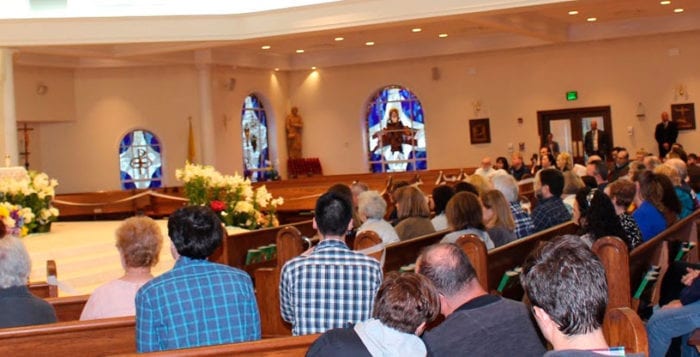
By Victoria Espinoza
After calls for more public discussions and town hall meetings from constituents in New York’s 1st Congressional District, U.S. Rep. Lee Zeldin (R-Shirley) held three town halls this past Sunday. Some praised Zeldin for his patience dealing with “organized protestors,” while other attendees were still left wanting more dialogue with their representative.
Cindy Morris, a Stony Brook resident, attended Zeldin’s third and final town hall of the day at St. Patrick’s Church in Smithtown.
“We’ve [progressive groups] been working very hard asking him to meet with us in a public forum since November,” Morris said in a phone interview. “This was his first attempt and I felt it was important to attend, both to thank him and show this is not an attempt for political theater like he’s claimed, but for real dialogue.”
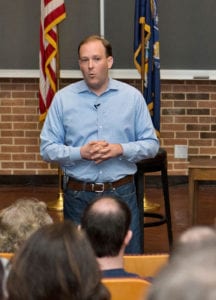 In a previous interview, Zeldin spokesperson Jennifer DiSiena said requesting a town hall with the purpose of disrupting it is wrong and wouldn’t be taken seriously.
In a previous interview, Zeldin spokesperson Jennifer DiSiena said requesting a town hall with the purpose of disrupting it is wrong and wouldn’t be taken seriously.
“Congressman Zeldin will meet with any constituent interested in a productive, substantive exchange of ideas,” she said. “He is not interested in the type of political theater that this group of liberal obstructionists is interested in promoting.”
DiSiena was addressing Project Free Knowledge, a group who hosted a “mock” town hall in Port Jefferson in March which featured a Zeldin impersonator and little effort for an impartial discussion. However, Zeldin has referred to different forms of protests by constituents in his district similarly.
But Morris insisted this meeting was nothing like the mock town hall. Unlike the first two town halls held earlier that day, where she said attendees did not have an opportunity for audience interaction, she praised the Smithtown event for being well-organized, giving some audience members a chance to ask a question off the cuff, that hadn’t been screened.
“He’s our congressional representative, and the representative piece of that is the most important part of his title,” she said. “We wanted to give him an opportunity to let him know what our values are, what we’re looking for.”
Morris also said after watching the first two town halls on Facebook Live, she recognized sound bites Zeldin had used repeatedly that day.
“There was certainly some messaging,” she said. “Until he’s willing to have a real conversation with his constituents, I think that’s literally political theater.”
The event was hosted by Catholics for Freedom of Religion, and President Barbara Samuells said she thought the event went very well.
“People were able to do what the event was intended for,” she said in a phone interview. “They were able to come forward in an open environment and ask questions.”
Samuells said the environment was respectful and calm, unlike other town halls she has seen across the country, and a variety of different issues were discussed. She also commended Zeldin on his directness, saying he answered questions honestly.
Residents wrote on Zeldin’s Facebook page praising him for attending the meetings. Bob Voss, of Mastic, recognized the congressman’s effort.
“Thank you once again for making yourself available to your district constituents and the opportunity to express their concerns whether there is agreement or not on an issue,” he said. “Most important is the knowledge, skill and ability to listen as opposed to talk/yell which may have various motivations. In community forums like these and when [they are] done with mutual dignity and respect much can be accomplished other than shouting.”
But others agreed with Morris, saying the conversation was not as direct as they would have liked.
Nicolle Zeman, who attended the Riverhead town hall, wrote on a Facebook page called Let’s Visit Lee Zeldin, which is comprised of people urging Zeldin to hold town halls. Many are harsh critics of the congressman.
“There was lots of rambling, avoiding answering direct questions and self-serving monologues,” she said. Zeman asked Zeldin about President Donald Trump’s (R) possible tax plan to eliminate the head of household filing status, and said Zeldin instead “rambled,” on about tax reform in general, and when she pressed him on the specific elimination he couldn’t say definitively if he would support the elimination or not.
Zeldin was one of Trump’s first supporters on Long Island, however as of late he seems to be putting some space between himself and the commander-in-chief.
“He did say a couple of times that Trump needs to clean up the way he speaks, that he’s no longer a television host, he’s the president,” she said. “He’s trying to find ways to distance himself from Trump but he’s voting for the Trump agenda.”
Morris acknowledged Zeldin is committed to fighting cuts against the Environmental Protection Agency and funding to the Long Island Sound, which is the opposite stance of Trump, however he “stands strongly with him,” on immigration and financial issues.
FiveThirtyEight, a website focusing on poll analysis and politics, gave Zeldin a 96 percent score for how often he votes in line with the president’s position on house bills. But in the most recent house bill to repeal an FCC rule stopping internet service providers from sharing data of customer’s activities, Zeldin voted no — the opposite of Trump’s position. The bill had almost unanimous Republican support.
Morris also said Zeldin’s staff was helpful after the events, approaching them and getting their contact information to keep them informed.
“They asked us if we would stop protesting, we used the hashtag #WhereIsZeldin, and they said we found him here, there’s no more reason to use it,” Morris said. “But I told them we wouldn’t stop after a one hour moment.”
After the town halls Zeldin said he enjoyed meeting with the people of his district that day.
“It was such a pleasure to meet with so many great constituents at today’s town halls to hear concerns and answer questions,” he said. “At the community forums, we were able to cover a breadth of very important issues, including health care, the environment, foreign policy, economic growth, several local issues, and so much more. I am willing to work with absolutely anyone to move our country forward, no matter what your ideological background is, and I welcome any opportunity to engage in substantive, productive dialogue.”
